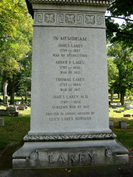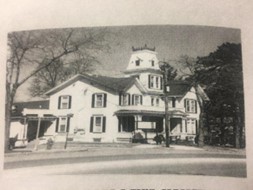
Abner Forbes Lakey, son of James Lakey and Charlotte Forbes, was born on March 19, 1787 in Upton, Worcester County, Massachusetts. He was the brother of Thomas Lakey, and brother-in-law of Pomeroy Tucker. (E. B. Grandin was also a brother-in-law to Pomeroy Tucker.)
In 1791, Abner’s father, a Revolutionary War soldier, moved his family to Buckland, Massachusetts. In that small agrarian community, his father purchased 50 acres for $300. He worshiped with the Methodist Episcopal Society. There remains today a Lackey Street and a Lackey Dam Road in Upton.[1]
As a youth, Abner was apprenticed to a watch and clockmaker before moving to Palmyra.[2] He set up a silversmith and cabinet shop in Palmyra just before the War of 1812 broke out. Abner was called to arms. After fighting for the United States along the Canadian border, he returned to Palmyra. In town, he was known as a man of many talents. However, there was a Puritan coldness that kept his children and townsfolk at a distance. His daughter Elizabeth Lakey recalled that he kissed her only once and then looked astonished. This was after he had been absent from home for two years.[3]
Between 1812 and 1834, Abner served the community of Palmyra as an overseer of highways (1812, 1823, 1826, 1828, and 1834).[4] In 1814, he registered his animal mark with the Palmyra Village—“a crop off the right ear and a half penny underside of the same.”[5] That same year, he was granted a deed from Isaac Arnold and a deed from John Russell.[6]
In 1828, Abner was listed as a freeholder and taxable inhabitant of District No. 13 in Palmyra and assessed $20 in taxes.[7] He built his home at 437 East Main Street. Next door to his home, he built the Eagle Hotel (later known as Throop’s Hotel). In the hotel, he had a cabinet shop.[8] This is a photograph of his home.

On July 26, 1828, at a political meeting of Palmyra residents the Eagle Hotel, Abner served as secretary and Gain Robinson as chairman. It was decided at the meeting that residents would support John Quincy Adams bid for US president.[9]
In 1828 or 1829, Abner assisted Lucy Mack Smith in obtaining papers to get Joseph Smith Sr. out of a jail. Lucy wrote,
They drove off with my husband, leaving me alone, with my little girl. The next morning, I went on foot several miles, to see a friend by the name of Abner Lackey; who, I hoped, would assist me; and was not disappointed. He went without delay to the Magistrate’s office, and had my papers prepared, so that I could get my husband out of the prison cell, although he would still be confined in the jail yard.[10]
In 1829, Abner purchased a corner lot at Johnson and Vienna Streets on which he built the house today known as the home of Admiral Sampson of Palmyra. On September 15, 1829, “Abner Lakey, Martin Harris, and Jeremiah Hurlbut do hereby formally select and discharge the Town of Palmyra and from all claims to damages which are penalty major can have for or by reason of this laying out of a road.”[11]
In 1830, Abner Lakey claimed—
Joe Smith owed him money, but not being able to pay, Smith said that the angel had told him not to sell the Book of Mormon for less than $1.25, but had given Lakey permission to see it for 35 cents if he would take his pay in books, which offer was declined.”[12]
In 1831, Abner drew architectural plans for the construction of the Western Presbyterian Church on Main Street in Palmyra. His architectural plans were accepted. Asa Millard was hired to be the contractor of the church building.[13]
On June 24, 1846, Abner wrote a letter addressed to “My dear children—I believe my life has been blest [sic] with more of this worlds good than most men I certainly would not object to running my race over again . . . I have undergone the last 4 years in trying to save the wreck of what was once a good estate for the benefit of my legal heirs.”[14]
On June 18, 1849, Abner married his third wife, Ann Gregg, a resident of Palmyra. They were married by Reverend L. H. Kellogg in the Western Presbyterian Church.[15] The 1850 US Federal Census lists sixty-three year old Abner as having a real wealth of $8,000. He died on September 16, 1856 in Palmyra.[16]
[1] Fannie Shaw Kendrick, The History of Buckland 1779–1935, pp. 132, 519.
[2] Pomeroy Developments in America, p. 65.
[3] The Life of Chauncey Giles: As Told in His Diary and Correspondence, p. 46.
[4] Old Palmyra Town Record.
[5] Old Palmyra Town Record.
[6] Ontario County, NY Grantee Deed Index, 1789–1845.
[7] “Early Freeholders, 1828, District No. 13,” Palmyra Historic Society.
[8] Troskosky, Palmyra: A Bicentennial, pp. 76, 95, 168; Cook, Palmyra and Vicinity, pp. 56, 89.
[9] “At a meeting of the inhabitants . . .,” Wayne Sentinel, August 8, 1828.
[10] Smith, History of Joseph Smith by his Mother, p. 174; Lucy Mack Smith, History, 1845, in Joseph Smith Papers.
[11] Old Palmyra Town Record.
[12] “Editorial Correspondence,” Baptist and Reflector, December 12, 1901.
[13] Western Presbyterian Church Records.
[14] See Durfee Scrapbook No. 1, 1831–1863.
[15] Durfee Scrapbook No. 1, 1831–1863.
[16] “Abner Lakey,” FamilySearch.
